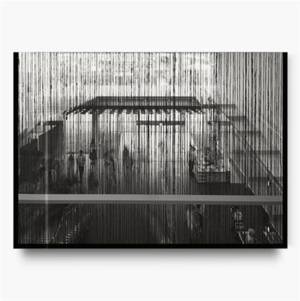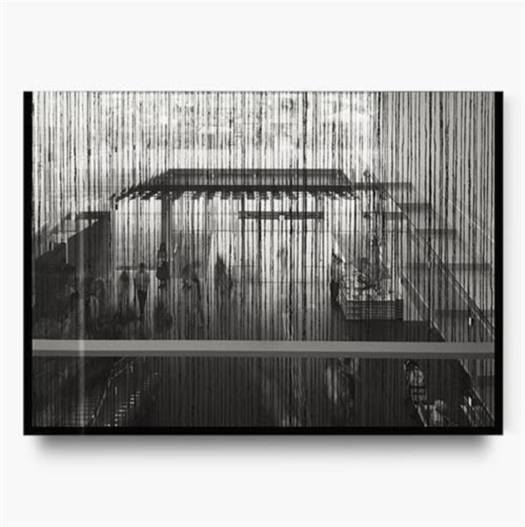
Bedankt voor het vertrouwen het afgelopen jaar! Om jou te bedanken bieden we GRATIS verzending (in België) aan op alles gedurende de hele maand januari.
- Afhalen na 1 uur in een winkel met voorraad
- Gratis thuislevering in België vanaf € 30
- Ruim aanbod met 7 miljoen producten
Bedankt voor het vertrouwen het afgelopen jaar! Om jou te bedanken bieden we GRATIS verzending (in België) aan op alles gedurende de hele maand januari.
- Afhalen na 1 uur in een winkel met voorraad
- Gratis thuislevering in België vanaf € 30
- Ruim aanbod met 7 miljoen producten
Zoeken
Omschrijving
Japanese architect Kengo Kuma and Greek-Israeli photographer Erieta Attali have been working together for over twenty years. Their joint work is characterized by a shared aesthetic understanding of architecture, space, and visual perception. In both Kuma’s buildings and Attali’s photographs, interior and exterior spaces merge and dissolve into one another. Both are united by the idea that spatial experience is fleeting, shaped by the rhythm of the day and the seasons, making built space a medium that expands into the landscape and encourages people to question their notion of spatial boundaries.
Attali’s photographs go far beyond documenting architecture. She focuses on the relationship between architecture and the ever-changing environment. Space and landscape are reordered through her visual language. Attali, who began her career as an archaeology and landscape photographer, has created a vast body of work over the past two decades. In this book, congenially designed by Koma Amok, Kuma’s architectural ideas are interpreted by Attali in such a way that the act of photographic translation creates independent works of art that can reveal their full power in this very special book/object.
Architectural sketches and quotes by Kuma are embedded in between Attali’s photographs, providing deep insights into the work created over the past twenty years. With an essay by Barry Bergdoll, head of the art history department at Columbia University and former curator of architecture and design at the Museum of Modern Art, this publication situates the work of Kuma and Attali at the center of contemporary architectural discourse.
In addition to well-known buildings, the selection includes a number of smaller, never-before-shown works from Europe, the United States, and Japan. Among them are the Glass Wood House, New Canaan, USA; the Mediation House, Krun, Bavaria, Germany; the Water Glass House, Atami, Shizuoka Prefecture, Japan; Sunny Hills, Tokyo, Japan; and the Coeda House, Shizuoka Prefecture, Japan.
Attali’s photographs go far beyond documenting architecture. She focuses on the relationship between architecture and the ever-changing environment. Space and landscape are reordered through her visual language. Attali, who began her career as an archaeology and landscape photographer, has created a vast body of work over the past two decades. In this book, congenially designed by Koma Amok, Kuma’s architectural ideas are interpreted by Attali in such a way that the act of photographic translation creates independent works of art that can reveal their full power in this very special book/object.
Architectural sketches and quotes by Kuma are embedded in between Attali’s photographs, providing deep insights into the work created over the past twenty years. With an essay by Barry Bergdoll, head of the art history department at Columbia University and former curator of architecture and design at the Museum of Modern Art, this publication situates the work of Kuma and Attali at the center of contemporary architectural discourse.
In addition to well-known buildings, the selection includes a number of smaller, never-before-shown works from Europe, the United States, and Japan. Among them are the Glass Wood House, New Canaan, USA; the Mediation House, Krun, Bavaria, Germany; the Water Glass House, Atami, Shizuoka Prefecture, Japan; Sunny Hills, Tokyo, Japan; and the Coeda House, Shizuoka Prefecture, Japan.
Specificaties
Betrokkenen
- Auteur(s):
- Uitgeverij:
Inhoud
- Aantal bladzijden:
- 268
- Taal:
- Engels
Eigenschappen
- Productcode (EAN):
- 9783960700746
- Verschijningsdatum:
- 30/11/2023
- Uitvoering:
- Paperback
- Afmetingen:
- 280 mm x 200 mm
- Gewicht:
- 683 g

Alleen bij Standaard Boekhandel
+ 88 punten op je klantenkaart van Standaard Boekhandel
Beoordelingen
We publiceren alleen reviews die voldoen aan de voorwaarden voor reviews. Bekijk onze voorwaarden voor reviews.









